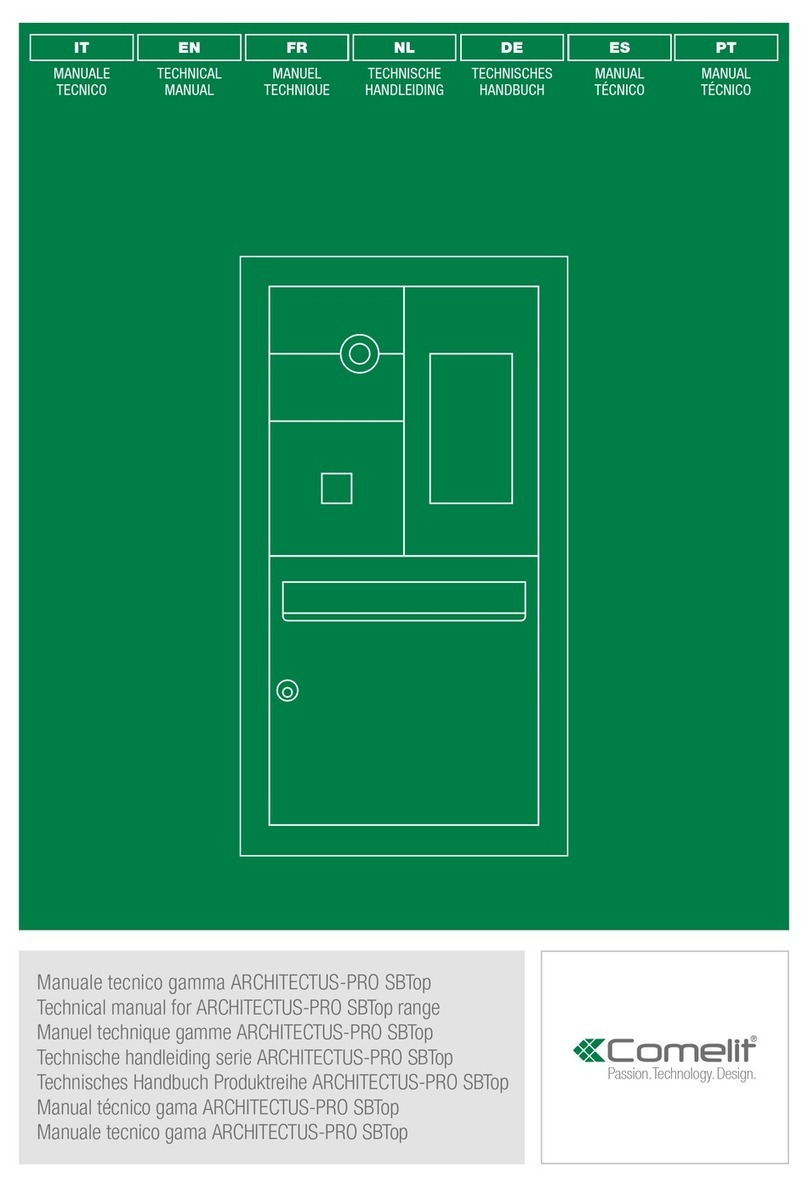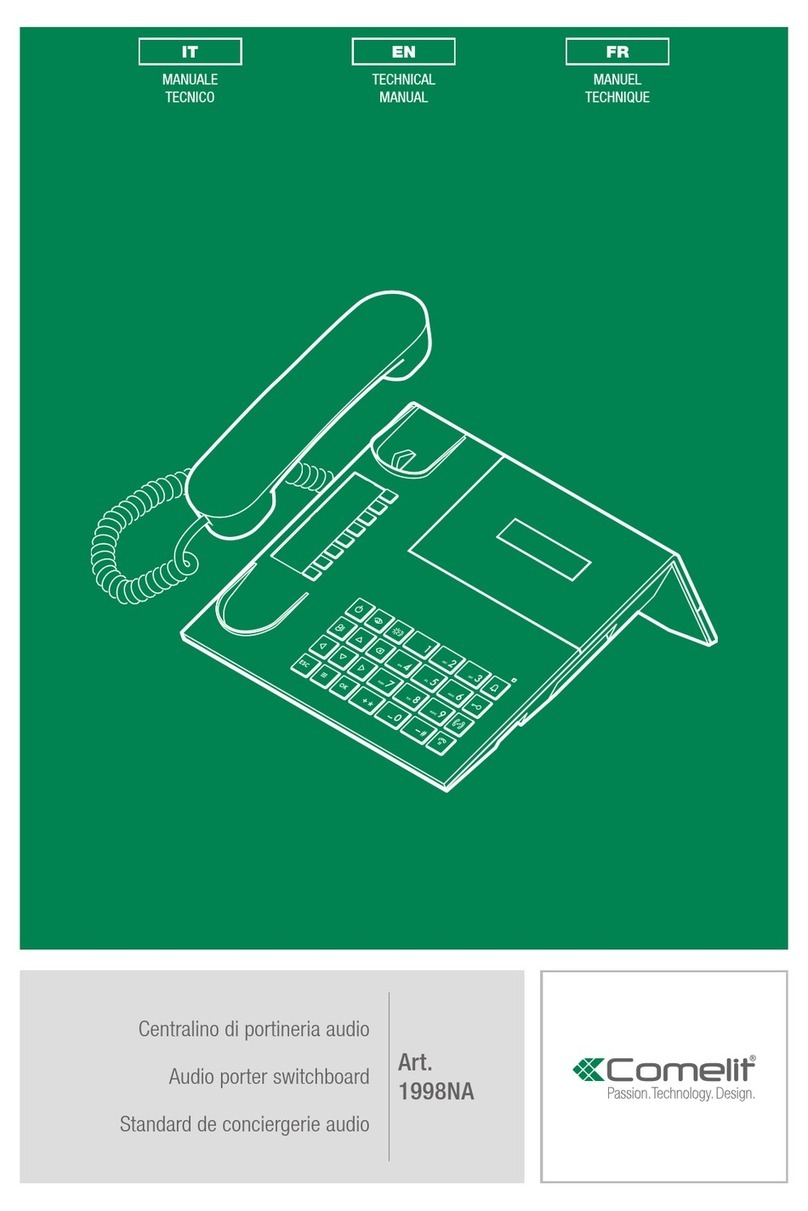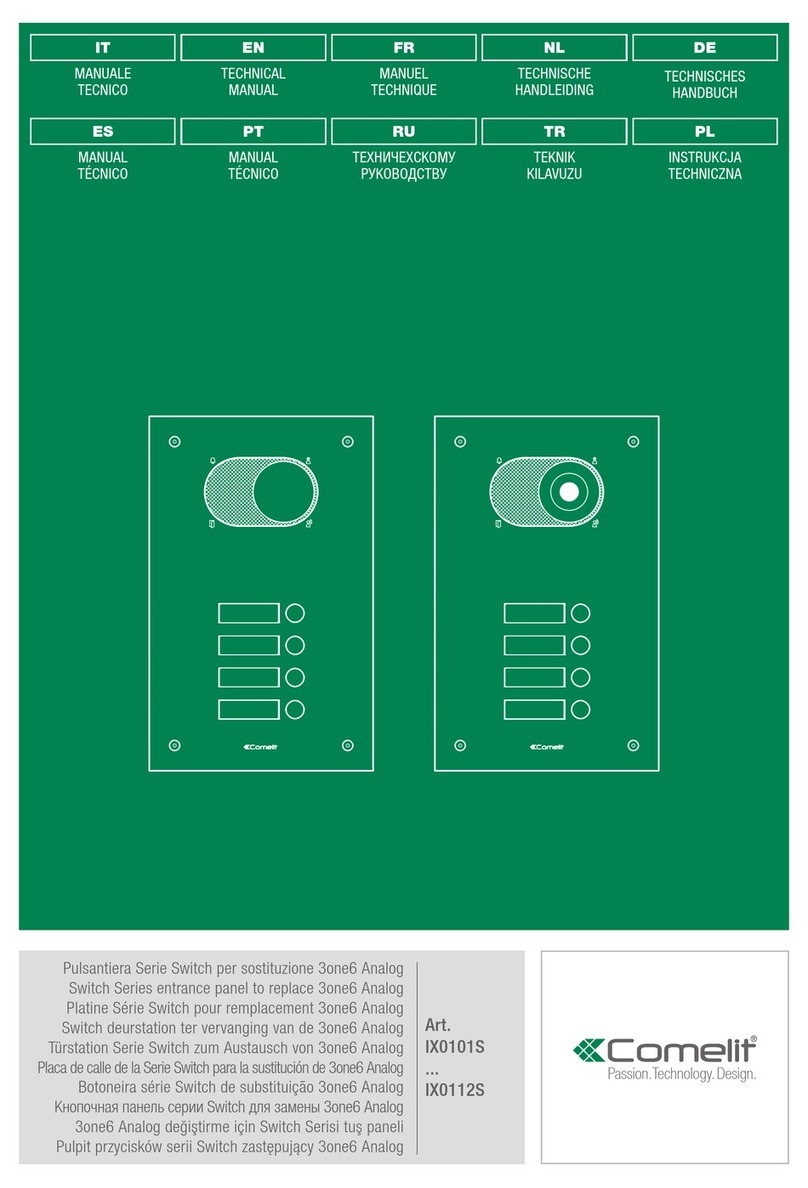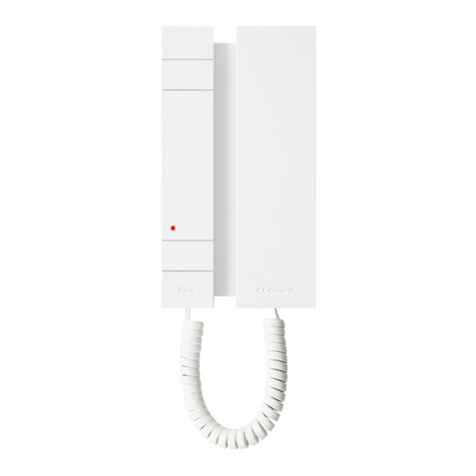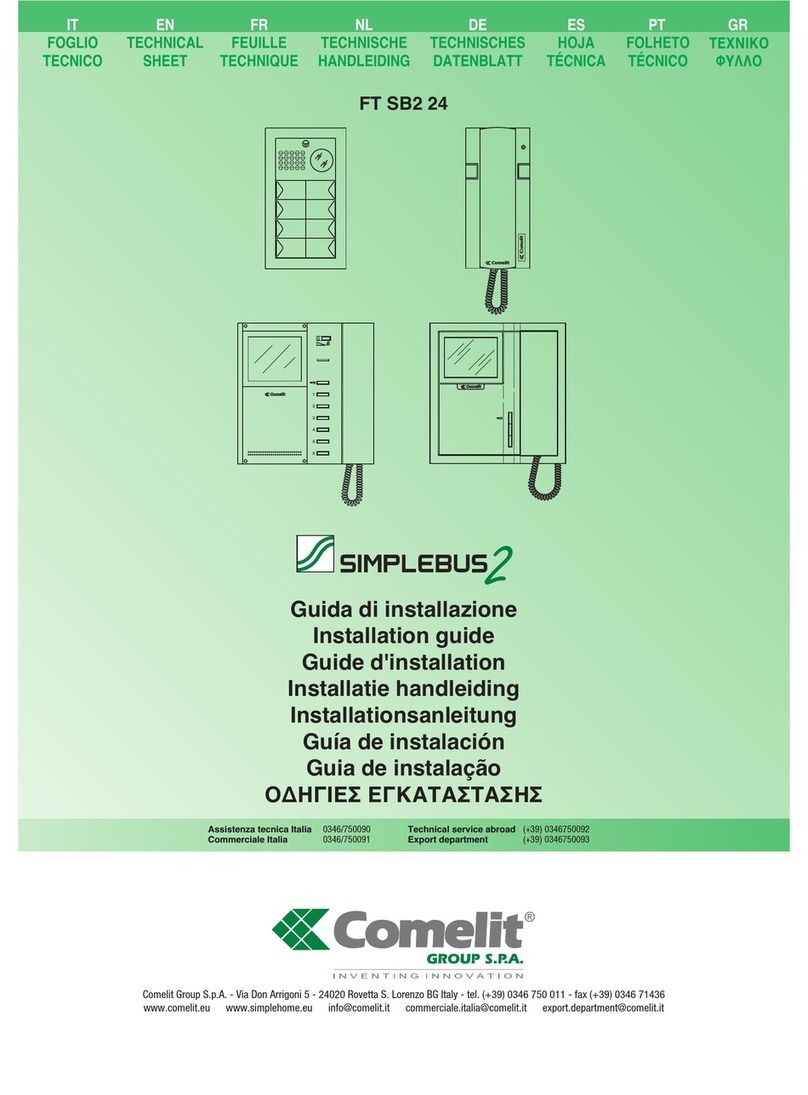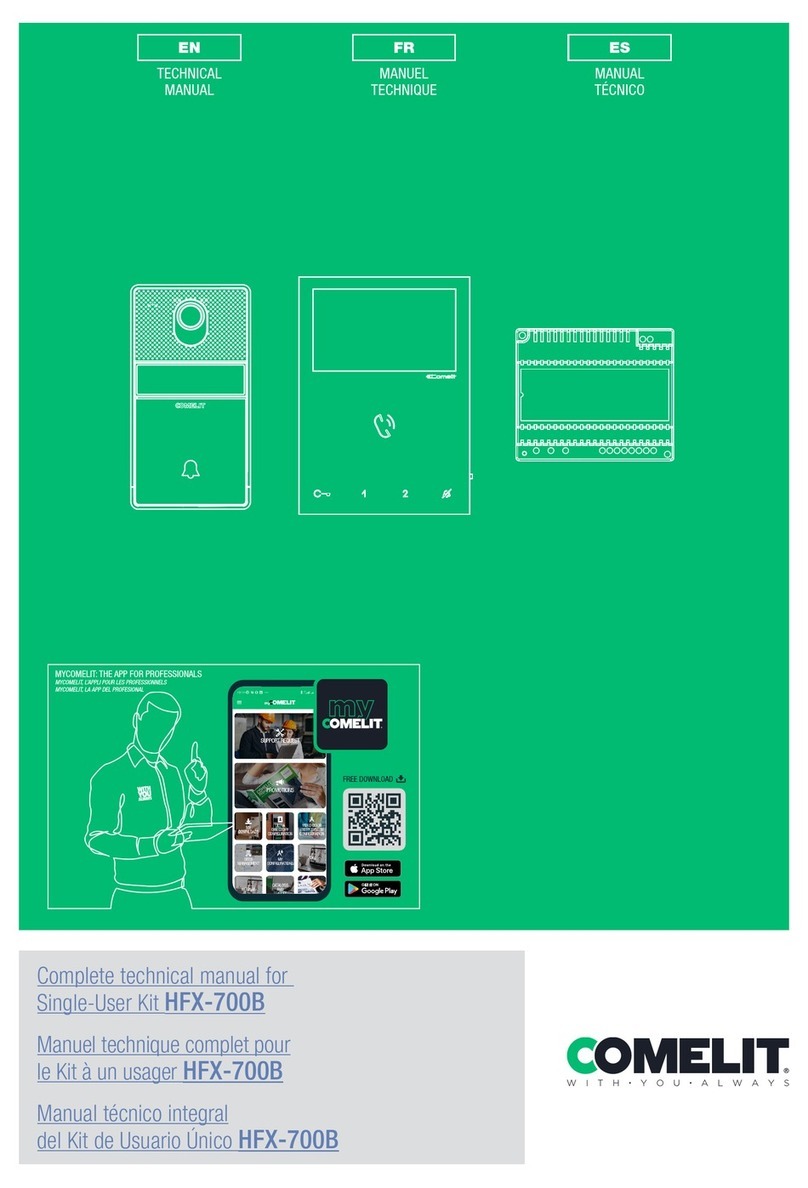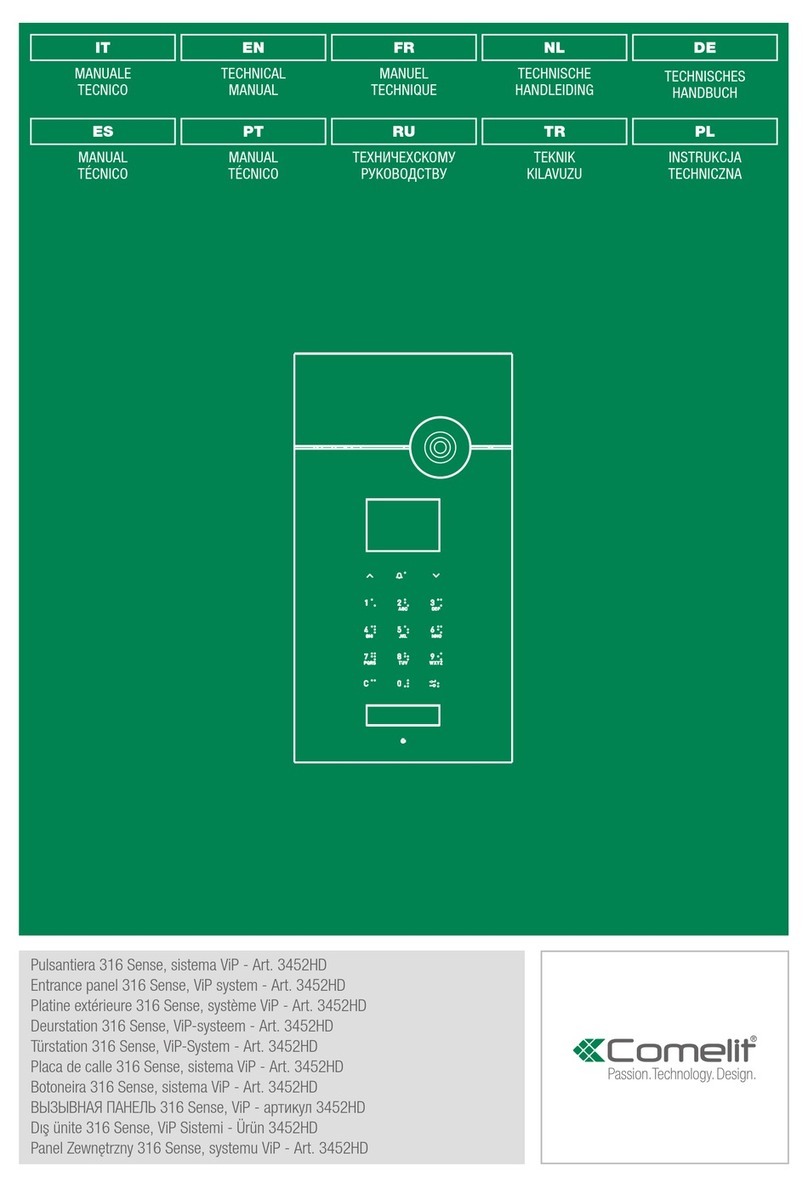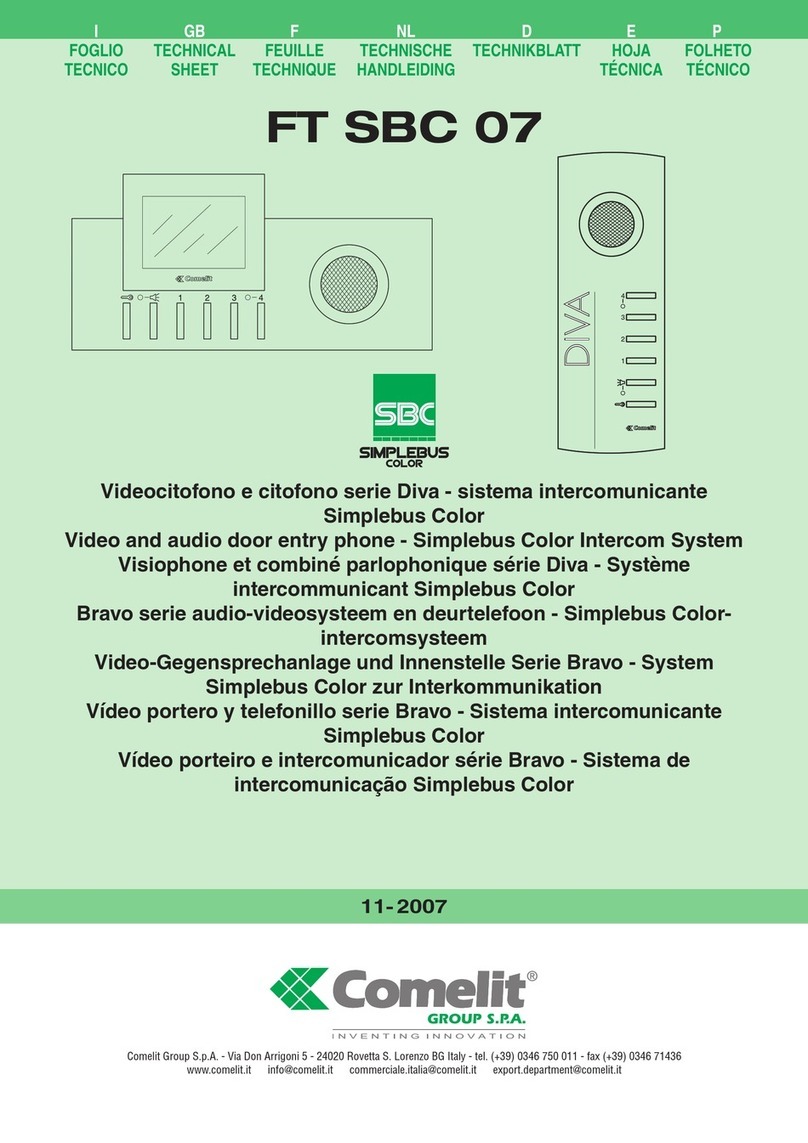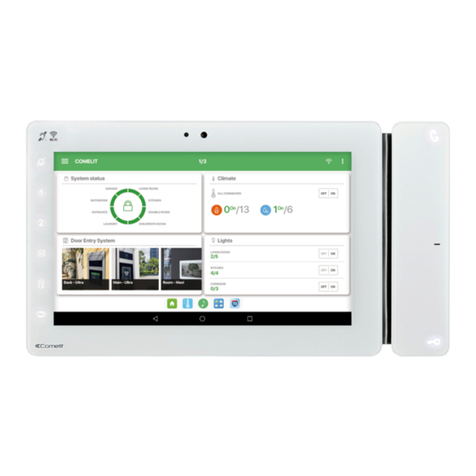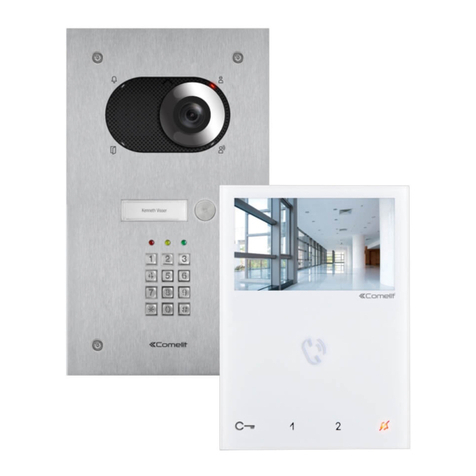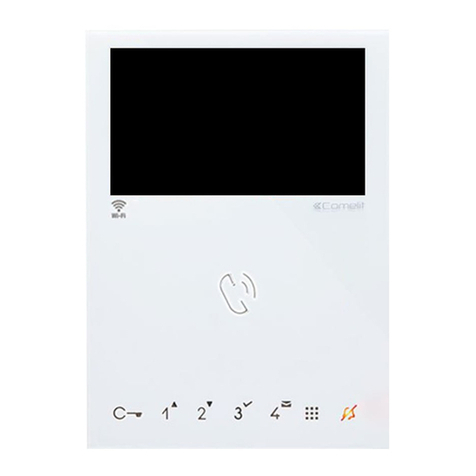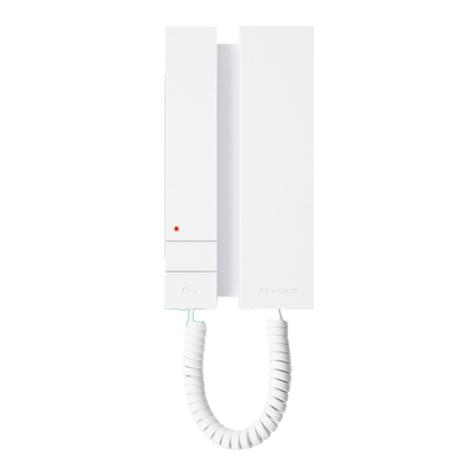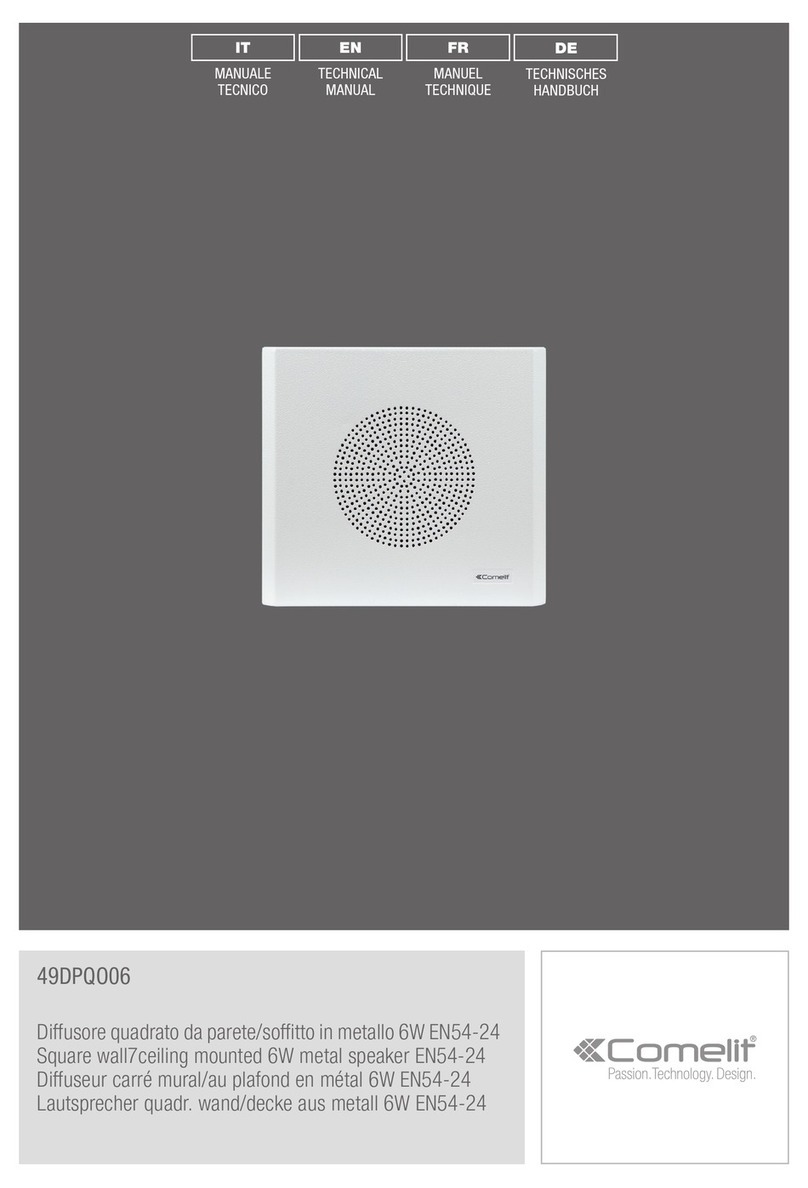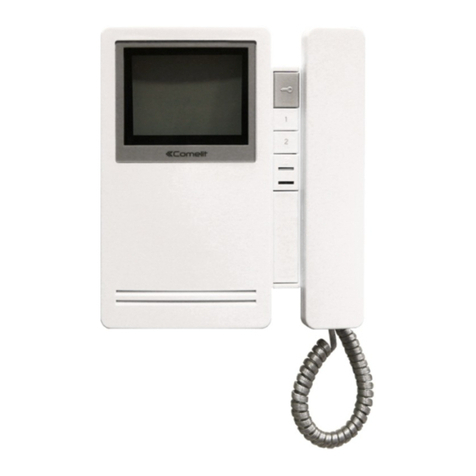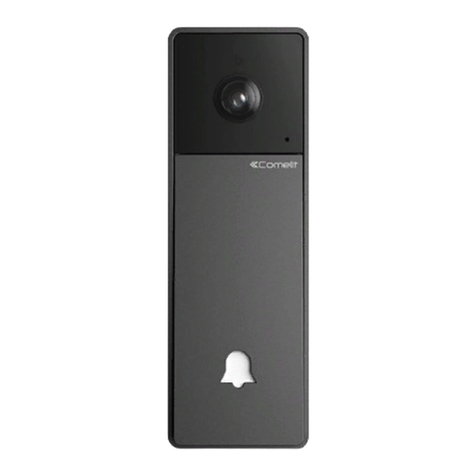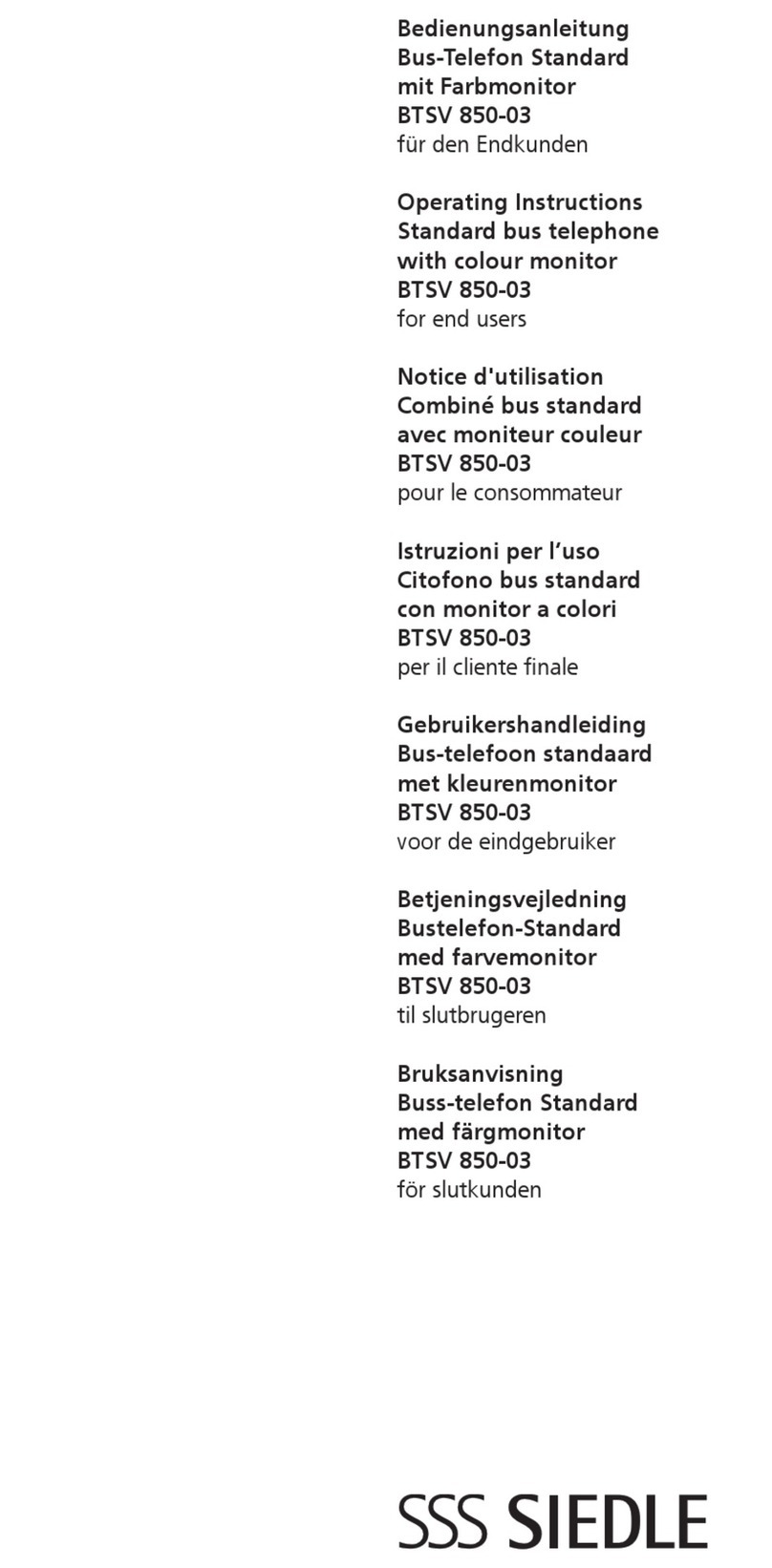FT CB 08
5FT CB 08
Fig. 1 Installazione Staffa Art. 5708 su scatola serie civile 503 (Art. 4517).
Fig. 2 Installazione a muro Staffa Art. 5708 con 4 viti a tassello. Utilizzabile
eventualmente anche con scatola serie civile 503 (Art. 4517) per
migliorare il fissaggio della staffa.
Fig. 3 Misure di ingombro del Monitor in relazione ai punti di fissaggio della
Staffa Art. 5708.
Fig. 4 Procedura di aggancio Monitor.
Fig. 5 Procedura per togliere il Monitor dalla staffa a cui è agganciato.
Fig. 6 1. Connettore Staffa-Monitor.
2. Morsetti di connessione impianto:
AL Morsetto ingresso comando allarme.
AP Morsetto di ingresso comando apriporta.
CAP Morsetto di ingresso chiamata da piano.
OUT1 Morsetto per uscita ausiliaria.
ALE Morsetto contatto allarme esterno.
PAN Morsetto contatto di panico.
CP2 Morsetto di ingresso chiamata a centralino secondario.
LED Morsetto di ingresso Led di segnalazione.
RFP Morsetto comando Relè scambio su chiamata digitale.
CFP Morsetto di ingresso chiamata porta tradizionale.
+24 Morsetto di alimentazione BUS.
LIN Morsetto di ingresso linea BUS.
4- Negativo Fonica.
3Morsetto di uscita microfono Monitor.
2Ingresso altoparlante Monitor.
SUscita ripetizione di chiamata.
+ - Ingresso di alimentazione Monitor positivo (+) e massa (-).
SH/V2 Schermo segnale video coassiale o V2 per segnale video
differenziale.
V/V1 Ingresso segnale video coassiale o V1 per segnale video
differenziale.
CPS COM Contatti NO (24V-100mA max) Pulsante 1 del Monitor.
(Vedi variante a pagina 14)
C2 P2 Contatti NO (24V-100mA max) Pulsante 2 del Monitor.
3. CV2_V1 Ponticello per la chiusura 75 ohm del segnale video, da
tagliare in caso di collegamento in cascata (sia nel caso di Segnale
video coassiale che differenziale).
CV2_V2 Ponticello per la chiusura 75 ohm del segnale video, da
tagliare in caso di collegamento in cascata (solo in caso di Segnale
video differenziale). Vedi variante a pagina 13).
4. CV1 CV3 Ponticelli da tagliare per liberare il Pulsante 1 (contatto NO
24V-100mA max).
5. JP4 - DL1 Jumper e Led di programmazione. In fase di programmazione
il led lampeggia.
6. CV4 Tagliare questo ponticello affinché su chiamata da posto esterno
o centralino, il Monitor suoni ripetutamente per un tempo massimo di
60 secondi se la cornetta non viene sollevata.
7. TM1 Trimmer di regolazione ampiezza segnale video.
Fig. 1 Installation of Bracket Art. 5708 on civil series box 503 (Art. 4517).
Fig. 2 Installation of Bracket Art. 5708 with 4 expansion screws. Can also be used
if necessary with civil series box 503 (Art. 4517) to improve Bracket fixing.
Fig. 3 Overall dimensions of the Monitor in relation to the fixing points of
Bracket Art. 5705.
Fig. 4 Procedure for mounting the Monitor.
Fig. 5 Procedure for removing the Monitor from the bracket it is hooked up to.
Fig. 6 1. Bracket-Monitor connector.
2. System connection terminals:
AL Alarm control input terminal.
AP Door-opening control input terminal.
CAP Local floor calling input terminal.
OUT1 Terminal for auxiliary output.
ALE External alarm contact terminal.
PAN Panic contact terminal.
CP2 Input terminal of call to secondary switchboard.
LED Signalling LED input terminal.
RFP Terminal for control of changeover Relay on digital call.
CFP Traditionalloval door call input terminal.
+24 BUS power supply Terminal.
LIN BUS line input terminal.
4- Sound negative.
3Monitor microphone output terminal.
2Monitor loudspeaker input.
SCall repetition output.
+ - Monitor power supply positive (+) and negative (-) input.
SH/V2 Coaxial screen video signal or V2 for differential video signal.
V/V1 Coaxial video signal input or V1 for differential video signal.
CPS COM NO Contacts (24V-100mA max) Pushbutton 1 of the
Monitor. See variant on page 14).
C2 P2 NO Contacts (24V-100mA max) Pushbutton 2 of the Monitor.
3. CV2_V1 Bridge for 75 ohm closing of the video signal, to be cut in the
case of cascade connection (both in the case of Coaxial and
differential video signal)
CV2_V2 Bridge for 75 ohm closing of the video signal, to be cut in the
case of cascade connection (only in the case of Differential video
signal). See variant on page 13..
4. CV1 CV3 Bridge to be cut to free Pushbutton 1 (NO contact 24V-
100mA max).
5. JP4 - DL1 Jumper and programming LED. During programming the
LED flashes.
6. CV4 Cut this bridge so that, on a call from the external unit or
switchboard, the Monitor rings repeatedly for a maximum time of 60
seconds if the handset is not picked up.
7. TM1 Video signal amplitude adjustment trimmer.
Fig. 1 Installation Bride art. 5708 sur boîtier série civile 503 (Art. 4517)
Fig. 2 Installation en saillie bride art. 5708 avec 4 vis tamponnées.
Éventuellement utilisable avec le boîtier série civile 503 (Art. 4517) pour
améliorer la fixation de la bride.
Fig. 3 Dimensions d’encombrement du moniteur par rapport aux points de
fixation de la bride Art. 5708.
Fig. 4 Procédure de fixation du moniteur.
Fig. 5 Procédure pour déposer le moniteur de la bride à laquelle il est fixé
Fig. 6 1. Connecteur Bride-Moniteur
2. Bornes de connexion installation
AL Borne d’entrée commande alarme
AP Borne d’entrée commande ouvre-porte
CAP Borne d’entrée appel palier
OUT1 Borne pour sortie auxiliaire.
ALE Borne contact alarme extérieure.
PAN Borne contact de panique.
CP2 Borne d’entrée appel au HP-micro secondaire.
LED Borne d’entrée led de signalisation.
RFP Borne de commande relais échange sur appel numérique.
CFP Borne d’entrée appel porte traditionnelle.
+24 Borne d’alimentation BUS.
LIN Borne d’entrée ligne BUS.
4- Négatif Phonie.
3Borne de sortie micro Moniteur.
2Entrée haut-parleur Moniteur.
SSortie répétition d’appel.
+ - Entrée d’alimentation Moniteur positif (+) et masse (-).
SH/V2 Écran signal vidéo coaxial ou V2 pour signal vidéo différentiel.
V/V1 Entrée signal vidéo coaxial ou V1 pour signal vidéo différentiel.
CPS COM Contacts NO (24V-100mA max) Bouton 1 du Moniteur.
Voir variante page 14).
C2 P2 Contacts NO (24V-100mA max) Bouton 2 du Moniteur.
3. CV2_V1 Pont pour la fermeture 75 Ohms du signal vidéo, à couper en
cas de connexion en cascade (aussi bien si le Signal Vidéo est coaxial
que différentiel).
CV2_V2 Pont pour la fermeture 75 Ohms du signal vidéo, à couper en
cas de connexion en cascade (seulement si le Signal Vidéo est
différentiel). Voir variante page 13.
4. CV1 CV3 Pont à couper pour dégager le Bouton 1 (contact NO 24V-
100mA max).
5. JP4 - DL1 Jumper et led de programmation. Durant la programmation
la led clignote.
6. CV4 Couper ce pontet pour que, lors de l’appel de la plaque de rue
ou du HP-micro, le moniteur retentisse à plusieurs reprises pendant
un délai maximum de 60 secondes, si on ne décroche pas le
récepteur.
7. TM1 Trimmer de réglage de l’amplitude du signal vidéo.
Staffa in programmazione Staffa non in programmazione
Bracket in programming mode Bracket not in programming mode
Bride en programmation Bride non en programmation
I
GB
F
